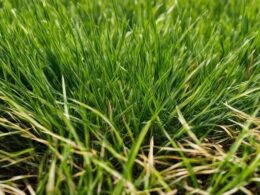Mowing your lawn at the right time is crucial for maintaining a healthy and beautiful yard. While opinions may vary on the best time to mow, there are some guidelines to follow.
Mowing wet grass, such as in the early morning, is not recommended as it can lead to tearing and disease. The mid-morning, between 8-10 a.m., is considered the optimal time to mow as the grass has dried from dew and is before the heat of the day.
Mowing during mid-day and mid-afternoon should be avoided as it can stress the grass and increase the risk of sunburn and heat exhaustion. Late afternoon, around 4-6 p.m., is the second best time to mow, allowing the grass to recover before nighttime.
Mowing in the evening is generally not recommended as the grass needs time to heal before dew develops. Additionally, the frequency of mowing depends on the season and the type of grass in your lawn. It is recommended to mow every four to six days during the summer months, being mindful not to cut off more than one-third of the grass height.
The Best Time to Mow Your Lawn Based on Grass Type
When it comes to maintaining a healthy and vibrant lawn, mowing at the right time is essential. However, the ideal time to mow your lawn can vary based on the type of grass you have. Different grass types have different optimal lawn heights, and it’s important to mow at the recommended height to ensure healthy growth and minimize stress on the grass.
For grass types like fine fescue, Kentucky bluegrass, perennial ryegrass, and tall fescue, the ideal lawn height ranges from 1.5 to 4 inches. On the other hand, grass types like bahiagrass, bermudagrass, buffalograss, carpetgrass, centipedegrass, St. Augustinegrass, and zoysiagrass have an ideal height range of 1 to 4 inches.
By mowing your lawn at the recommended height, you allow the grass to maintain its health, prevent discoloration and yellowing, and reduce vulnerability to disease and weeds. Remember, over-stressing the grass by cutting it too short can have negative consequences for its overall health.
It’s also crucial to avoid cutting off more than one-third of the grass height at a time. Regular mowing, keeping this guideline in mind, promotes proper lawn maintenance and ensures a well-maintained and attractive lawn.
Lawn Mowing Schedule Based on the Season
The frequency of mowing your lawn depends on the season and how fast the grass grows. Here’s a recommended lawn mowing schedule to keep your yard looking its best throughout the year:
Spring:
In spring, start mowing once every week or every other week, as the growth is not yet rapid. This will help remove any winter debris and promote healthy grass growth as the weather warms up.
Summer:
As summer arrives, increase the frequency to every four to six days, adjusting as per your grass’s growth pattern. During periods of hot weather, it is crucial not to cut off more than one-third of the grass length to avoid stress and damage. Keep an eye on the weather and adjust your mowing schedule accordingly.
Autumn:
In autumn, mow once a week, gradually raising the mower blades as winter approaches. This will ensure the grass is at a suitable length before the colder months. By the end of fall, stop mowing about a week before the first frost to prepare the lawn for winter.
Winter:
In winter, mowing is generally not necessary unless the grass is still growing due to unseasonably warm temperatures. If you do need to mow in winter, ensure the ground is frost-free and reasonably dry before doing so.
Following a seasonal lawn mowing schedule will help maintain the health and appearance of your lawn year-round. Remember to adjust the frequency of mowing based on grass growth, weather conditions, and the specific needs of your lawn type.
What Time of Day Should You Mow Your Lawn?
Choosing the best time of day to mow your lawn is essential for maintaining its health and appearance. Several factors come into play when determining the optimal mowing time. Let’s explore the different options and find the most suitable one for you.
Mowing your lawn early in the morning, between 6-8 a.m., is not recommended. At this time, the grass is still wet from the morning dew, making it prone to tearing and disease. To ensure the well-being of your lawn, it’s best to wait until mid-morning, between 8-10 a.m. During this period, the grass has dried, and it has ample time to heal before evening arrives. Mowing during mid-day, between 10 a.m. to 2 p.m., is generally safe; however, the high temperatures can be too hot for both the grass and the mower.
The second-best time to mow your lawn is late afternoon, between 4-6 p.m. By mowing during this time, your grass has enough time to recover before nightfall. On the flip side, mowing in the evening, after 6 p.m., is not recommended. At this hour, dew starts to form, leaving the grass susceptible to disease and hindering its healing process.
Remember, finding the optimal time to mow your lawn is crucial for its well-being. By choosing the right time of day, you can help maintain a healthy and vibrant lawn that will be the envy of the neighborhood.
Factors to Consider for Lawn Mowing
Besides the time of day, there are several other important factors to consider for optimal lawn mowing. These factors can help you maintain a healthy and well-maintained lawn:
- Avoid mowing wet grass: Mowing wet grass can lead to tearing, promote disease, and damage your mower. It’s best to wait until the grass is dry before mowing.
- Maintain and sharpen mower blades: Regularly maintaining and sharpening your mower blades will ensure a clean cut and prevent damage to the grass.
- Adjust mower height: It’s important to adjust the mower height according to the recommended height for your specific grass type. This will ensure proper growth and avoid scalping the grass.
- Avoid mowing too short: Mowing your lawn too short can stress the grass, causing it to turn yellow or brown and become more susceptible to weeds and disease.
- Consider the season and weather conditions: When scheduling your mowing frequency, take into account the season and current weather conditions. Adjust as necessary to promote healthy grass growth and maintain an attractive lawn.
By considering these factors, you can ensure that your lawn remains in optimal condition and continues to thrive.
Should I Adjust My Lawn Mowing Hours if I Use Weed and Feed Before or After Mowing?
When considering the timing tips for weed and feed, it’s best to mow your lawn before applying the product. This allows for better absorption of the weed and feed into the grass. Mowing after application can disturb the product and reduce its effectiveness. Plan your lawn care schedule accordingly.
Conclusion
Proper timing of lawn mowing is crucial for maintaining a healthy and beautiful lawn. Mowing your lawn at the right time of day, such as mid-morning or late afternoon, allows the grass to heal before evening and avoid stress from heat and sunburn.
When determining the frequency of mowing, it is important to consider the season, grass type, and weather conditions. Following the recommended mowing guidelines for your specific grass type and avoiding over-stressing the grass by not cutting too short or too frequently will promote healthy growth and a vibrant lawn.
Additionally, factors such as mower maintenance and adjusting the mower height play an important role in lawn care. Regularly maintaining and sharpening the mower blades will ensure a clean cut and prevent damage to the grass. Adjusting the mower height according to the recommended height for your grass type will promote proper growth and prevent scalping.
Remember to avoid mowing wet grass as it can lead to tearing, disease, and damage to the mower. Lastly, be a considerate neighbor and adhere to any local noise regulations when mowing your lawn. By following these tips, you can have a well-maintained and pleasing lawn throughout the year.










